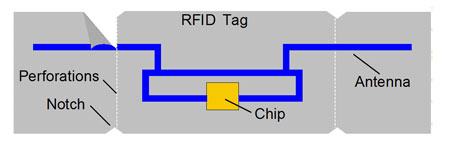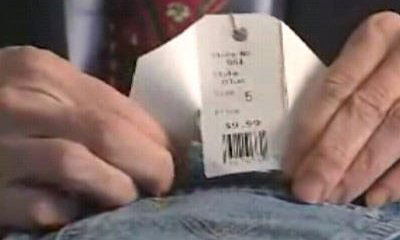by Günter Karjoth and Paul Moskowitz
Existing methods designed to protect consumer privacy in RFID either put the burden on the consumer or suffer from the very limited capabilities of today's RFID tags. By using 'clipped' tags, consumers are able to physically separate a part of the antenna from the tag in an intuitive way. Such a separation provides visual confirmation that the tag has been turned into a proximity tag. Deliberate action on the part of the owner is then required to permit the RFID tag to be read. This mechanism enables controlled reuse after purchase, making the clipped tag a viable addition to the privacy mechanisms proposed for the use of RFID by consumers.
Radio Frequency Identification (RFID) tags typically are small devices that can be embedded in or attached to objects for the purpose of identifying the object over a radio channel. Objects tagged with RFID technology can be read more easily and more frequently, thus improving the quality of information on objects in a supply chain or in the inventory of a warehouse. RFID tags can be read if they are within range (typically up to a few metres) of a reader, which communicates with tags over a radio channel without requiring a line of sight. However, these characteristics of RFID tags have raised privacy concerns.
Retailers are constrained in the technology they use to protect consumer privacy. Stringent cost requirements limit the computational power of RFID tags, which in turn limits the mechanisms that could give users control over the use of their data in back-end systems. Existing solutions either put the burden on the consumer, which may include the risk of illegal behaviour, or are hampered by the very limited capabilities of inexpensive tags. Until now the 'kill' command seems to be the solution with the greatest potential. However, it is still necessary to overcome its three major weaknesses: complex key management, no (controlled) reuse after purchase, and no (visual) confirmation of successful disablement. In response to these limitations, we propose an RFID tag structure that permits consumers to disable a tag by mechanically altering it. We call such structures 'clipped tags', since a portion of the antenna is separated from the tag.

The mechanical alteration inhibits the ability of a base station or reader to interrogate the RFID tag or transponder by wireless means, and provides visual confirmation that the tag has been deactivated. Once a tag has been disabled (or 'clipped'), the distance over which it can be read is drastically reduced. Later use would require deliberate actions on the part of the owner of the RFID tag to permit the tag to be read, and thus could not be undertaken without the owner's knowledge unless the item were either stolen or left unattended. This makes it an appropriate mechanism to implement consumer consent.
Clipped tags are a simple and practical privacy-enhancing technique for RFID retail. Disabling can be performed in an easy, reliable and verifiable way. Even if the RFID tag is 'printed' onto a product, its antenna can be partially removed. Whereas the physical destruction of a tag would likely damage the original item, clipped tags provide a practical way to separate the antenna. For instance, we have demonstrated paper labels with an RFID tag inside. The tag comprises an antenna, which is printed, etched or stamped onto a substrate (eg a plastic foil), and a silicon chip attached to it. If necessary, another plastic foil may cover the tag to protect it from inclement environments. Such labels are then affixed to objects, and stored information may be written and rewritten to the embedded chip.
There are a number of possible ways of making clipped tags. One preferred structure uses perforations like those on postage stamps, which are manufactured into the antenna and its substrate. A separation along the line of small holes or cuts then detaches a portion of the antenna from the tag. Figure 1 shows a schematic of a clipped tag employing perforation. The notches additionally provide tear initiation, similar to the slits placed in ketchup packets. When torn, a portion of the antenna is removed.
In another example, the antenna may be constructed of conducting 'scratch-off material'. This material is familiar to consumers from its use to obscure printed material on lottery tickets or prepaid phone cards. The antenna of the RFID tag is manufactured on a substrate using the scratch-off material. The substrate or mount may be a plastic material such as polyimide or polyester. The chip is mounted on the substrate and is connected to the antenna by an electrical conductor or conductors. The RFID tag is manufactured in such a way that a part or all of the antenna or its connecting wiring is exposed. The electrical conductor or conductors pass through a window, such as an exterior portion of the substrate or mount. Such tags are placed on the article or on its packaging in such a way that the antenna or the antenna-chip connection can be scratched off using a coin or fingernail. The consumer or a check-out attendant in a retail establishment may then perform the scratch-off operation to disable interrogation of the tag. The tag is open for visual confirmation that the tag has been deactivated.

To demonstrate that such physical structures can be embedded in today's manufacturing process, IBM has been collaborating with Marnlen RFiD, a leading manufacturer of RFID labels, to design and manufacture samples of garment hang tags. The starting point was the Alien Technology, ALL-9440 (Squiggle 2.2) Gen2 UHF RFID tag inlay. This tag may be read at distances of 30 feet (10 metres). The Alien tag inlay was incorporated into a printable garment hang tag or label by Marnlen RFiD. We have also experimented successfully with inlays from other manufacturers: Symbol, Intermec, and Impinj.
The label contains notches for tear initiation and perforations to direct the tear. The design is consistent with the printing of graphics and the writing of tag information in a standard RFID printer. Marnlen RFiD manufactures clipped tag labels using standard RFID inlays. The tag design is compatible with commercially available readers and printers. Figure 2 shows an RFID tag inlay incorporated into a printable garment hang tag or label. The hang tags may be torn at the point-of-sale by the consumer to remove parts of the antenna. The result is a reduction in tag read range from 10 metres to about 2 cm.
Link:
http://en.wikipedia.org/wiki/Clipped_Tag
Please contact:
Günter Karjoth, IBM Zurich Research Laboratory, Switzerland
E-mail: gka![]() zurich.ibm.com
zurich.ibm.com
Paul Moskowitz, IBM Watson Research Center, Hawthorne, NY, USA
E-mail: mosk![]() us.ibm.com
us.ibm.com










